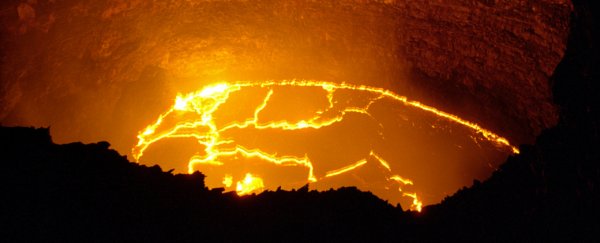Exactly how molten magma erupts from the depths of a volcano to the surface remains one of volcanology's biggest unsolved mysteries, but wall-crawling robots being developed researchers at NASA's Jet Propulsion Laboratory in California are well on the way to figuring out what goes on down there.
Unlike regular cave diving, plunging into a volcanic conduit capable of erupting at any moment isn't exactly feasible, but last year, the pioneering VolcanoBot 1 managed to send 90-degree views from 25 metres deep inside two never-explored fissures at Hawaii's Kilauea volcano.
The long, narrow fissures were among 54 cracks discovered so far by Carolyn Parcheta from the University of Hawaii and her team, who developed the technology. The researchers have now teamed up with JPL engineers to come up with a new iteration called VolcanoBot 2, and they're already working on VolcanoBot 3 - a four-wheeled, sensor-carrying robot that can crawl deeper and send more data from inside volcanic crevices than has ever been possible before.
The goal is to create a 3D model of the interior of an inactive conduit at Hawaii's Kilauea Volcano - and perhaps, in the distant future, on other planets.
"We're still about 10 years away from predicting an eruption, honestly. But if we can understand how magma erupts through a conduit, it's conceivable that we might be able to one day predict a violent eruption," Parcheta told ScienceAlert.
Just 10 inches (25.4 cm) long, VolcanoBot 2 is smaller, lighter and packed with more technology than VolcanoBot 1. It can turn, look at, and zoom in on features around it, said Parcheta, who specialises in the geometry of volcanic conduits. And VolcanoBot 3 will be even slicker.
"VolcanoBot3 is going to be very bare bones compared to VolcanoBot2. We're getting it right this time," said Parcheta. "All we have on it now is a prime sensor, infra-red and two computers - we've stripped out all the extra stuff that's not essential. Once we get the basic platform done over the summer and test it here at JPL, then will look at possibly adding more instruments."
Eager to explore the use of fissure-diving robots for extraterrestrial purposes, NASA scientists quickly realised the value of Parcheta's research, said Arron Parness, a JPL researcher and Parcheta's co-advisor on the project. "In the last few years, NASA spacecraft have sent back incredible pictures of caves, fissures and what look like volcanic vents on Mars and the moon," he said in a press release. "We don't have the technology yet to explore them, but they are so tantalising. Working with Carolyn, we're trying to bridge that gap using volcanoes here on Earth for practice."
Along the way, data being collected by robots could result in early warning systems for populous volcanic islands like Hawaii. "We don't know exactly how volcanoes erupt. We have models but they are all very, very simplified," said Parcheta. "In order to eventually understand how to predict eruptions and conduct hazard assessments, we need to understand how the magma is coming out of the ground. This is the first time we have been able to measure it directly, from the inside, to centimetre-scale accuracy."

